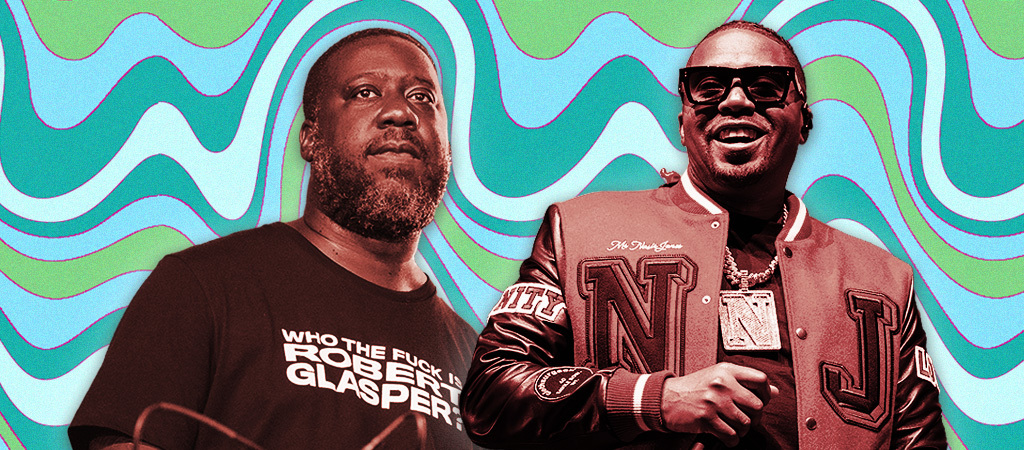
Jazz thrives in cities with history: New Orleans, New York, Los Angeles, Chicago. These cities are also places where you’d expect a new festival to pop up and have success, taking full advantage of a post-pandemic hunger for live music. The California iteration of the Blue Note Jazz Fest, now in its second year, is hundreds of miles away from these hubs for the genre, tucked between the beautiful peaks and canyons of Napa Valley.
This year’s Blue Note, sharing a name with the legendary label it’s created by, is centered around a lineup that pays tribute to the 50th anniversary of Hip-Hop. Mary J. Blige, Nas, and Chance the Rapper are in the headliner spots, with sets from Ari Lennox, Smino, De La Soul, Bilal, Lalah Hathaway, and a host of other greats across the Black music space who are all connected to, influenced by, and champions of hip-hop.
Hip-hop’s birth can be directly traced back to the Bronx in 1973, where turntables and spoken word collided. By the ’80s, its reach had gone far beyond the borough; artists began to reach for more complicated beats and lyrics that represented a complex image of the Black experience. Jazz samples built the bones for many of these songs, while the Jazz ethos built the attitude. Artists like Rakim & Eric B. and A Tribe Called Quest are the golden standard of this period: music that is urgent, frenetic, skillful. Created for and by Black people.
After inspiration from jazz fell out of fashion through the ’90s and early 2000s, its direct connection to hip-hop came back to center in a big way with To Pimp A Butterfly, the 2015 project that’s widely considered Kendrick Lamar’s best effort. It’s a dense, cerebral album layered with live jazz so complex that sometimes it’s hard to tell where the horns and drums end and the rapping begins. Despite its ambitious and politically-charged format, it was a monumental, critically acclaimed statement from rap’s newest visionary.
Robert Glasper, the jazz producer and pianist, was instrumental in many aspects of TPAB, from its jazz-centered concept, to writing and session playing for the album’s keyboards and synths. The record became a modern statement of excellence in every corner of music that it touched. Kendrick was elevated to great status, and brought those who were critical to the record’s creation with him into that arena, including Glasper. From that moment on, he became a connecting figure between modern jazz and hip-hop. Glasper is, without a doubt, taking up the mantle of being jazz’s most prolific and present leader.
Robert Glasper’s history with Blue Note is direct: he’s had an annual residency at their club in New York for years. Once the West Coast concept for a festival was solidified, Blue Note label head Steve Bensusan tapped Glasper personally to help him curate the lineup and get his network of West Coast jazz friends and collaborators onboard. Many of the same artists he’s performed with during his residencies and on his records are slated to make appearances at this year’s fest, all contributing to the small-world feel of the lineup.
“The club becomes the engine which then drives some of the other concerts or events that we produce in that market,” Bensusan explained to me while on-site at Silverado Resort a couple months ahead of the fest. After opening a club in Napa in 2019, then hosting a successful outdoor series and big-stage events, a festival was the next big step to conquer the music market in wine country.
The Napa version of Blue Note is designed to be more intimate than its East Coast sister event, which has existed since 2011. In Napa, attendees have the chance to experience multiple stages and genres on mid-sized grounds, without the overwhelming setup and crowds of most other festivals. This setup creates an experience where the music is central, and artists are more likely to be on top of their game and feed from one another’s energy.
With Glasper’s influence, Blue Note Napa is a gathering ground for new West Coast icons like Glasper, Terrace Martin, and Anderson .Paak to assemble, while giving shine to legends like George Clinton, Madlib, and Bobby McFerrin. Even though many of the festival’s acts aren’t straight-ahead jazz artists, the legacy of its name implies a certain air of musicianship that needs to be lived up to.
“Most of the time on the festival stage, you go see that one artist and that’s what you see, that’s what the festival is,” Glasper told us last year ahead of the festival’s first outing. “This one’s gonna be more cross-pollination, with a family-oriented kind of vibe. It’s smaller than most festivals on purpose,” he continued.
This year’s celebration of hip-hop is an important milestone, where the modern prestige of jazz and the acknowledgment of hip-hop as essential are both celebrated. Glasper himself explained it best: “There are so many amazing artists and trailblazers [in Black music] and to have them all in one festival represents so much and represents how free the music can be.”
Blue Note has the potential to be much more than a festival – the lineup alone can stand as music history: tracing the evolution of Black music at a time when it’s more present than ever in mainstream consciousness. Jazz is often considered prestige music, inaccessible to people who are young and disconnected from its history. Expertly curated lineups focused on a multi-generational slate of artists, like Blue Note Jazz Festival Napa, have the potential to connect the dots between all Black genres and make their relevance more apparent than ever.
